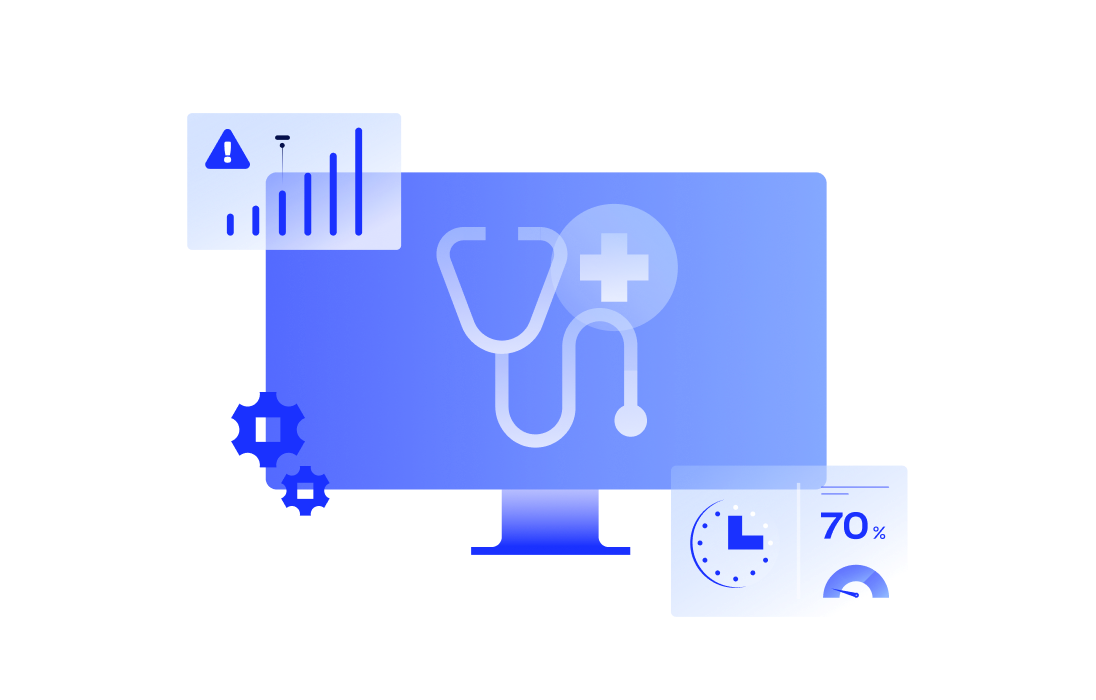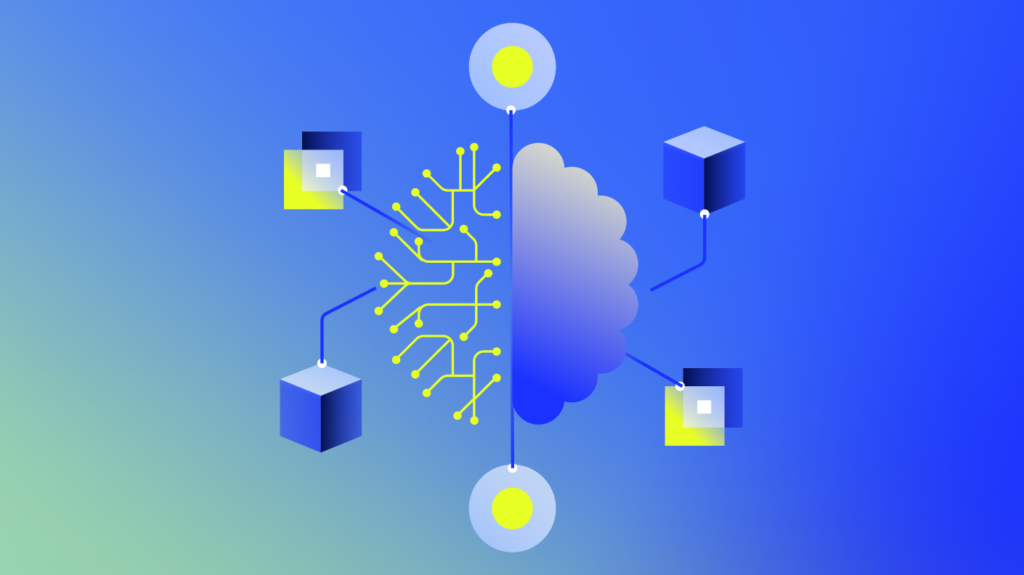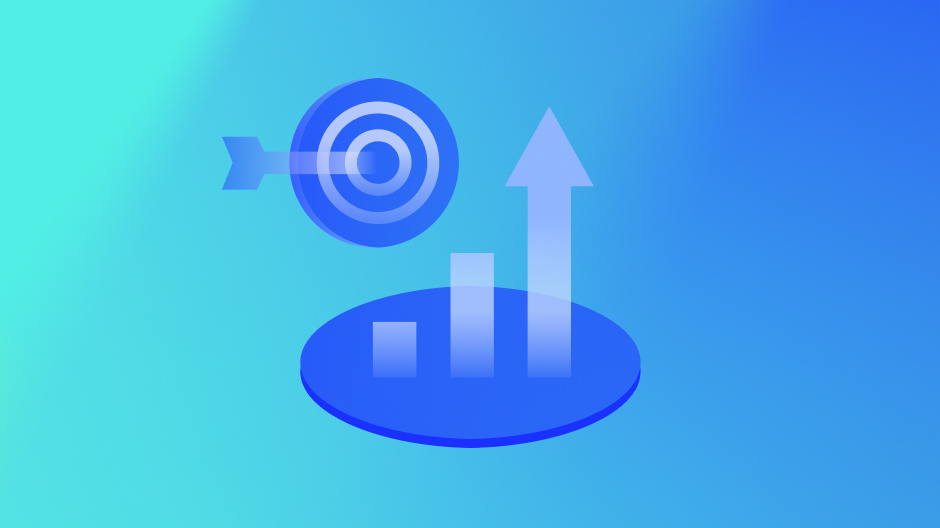In healthcare, every second matters. Healthcare IT infrastructure is the backbone of modern patient care delivery, ensuring that patient data is accessible, treatments are administered on time, and critical, life-saving systems remain operational. When these systems fail, the consequences are immediate and far-reaching—delayed treatments, disrupted workflows, and compromised patient safety. As an IT leader, it’s your responsibility that essential systems are running smoothly through optimal IT solutions for healthcare, minimizing risks to operations and safeguarding patient outcomes.
The complex challenges of healthcare IT
Your role puts you at the forefront of integrating cutting-edge technology, from IoT sensors and high-resolution imaging to AI-driven diagnostics. These new technologies transform how healthcare is delivered and improve patient care. However, these technologies come with increased complexity. Your healthcare facility likely relies on a mix of cloud-based and on-premises systems, from EHR platforms to lab and imaging software, all of which must seamlessly interact to deliver care. Yet, when systems fail to integrate properly, it results in delayed workflows, disconnected data, and, ultimately, a compromised ability to deliver quality care. This increasing complexity isn’t just a technical issue; it’s a mission-critical challenge that affects every layer of your organization, whether a hospital, health system, clinic, laboratory, or any other type of health or pharma-related operation.
Downtime disrupts everything—from clinical care to your back-office operations. Staff move from automated systems to manual processes, doubling their workload and risking errors. This leads to operational inefficiencies that ripple throughout the hospital, from patient records to pharmacy systems.
The far-reaching impacts of IT downtime in healthcare
As you know, the financial impact of downtime is enormous. Downtime significantly increases operational expenses, costing the healthcare and life sciences industry an estimated $203 million each year. In 2023, reports estimated that cyberattacks alone cost an average of $1.3 million per healthcare organization, severely disrupting system availability and normal operations. The stakes are high, and these challenges hit your bottom line as hard as they hit your IT infrastructure. But it’s not just financial; downtime impacts patient safety, delaying critical treatments and putting lives at risk.
When your systems are down, every second counts. Take the example of the Microsoft Microsoft outage in July of 2024 caused by a CrowdStrike issue, which disproportionately affected the healthcare industry, resulting in $1.94 billion in losses (individual companies faced average losses of $64.6 million.)
Downtime impacts not only finances but also patient safety. Disruptions in critical systems like EHRs and patient management platforms delay time-sensitive treatments, leaving life-saving medications or procedures stuck in queues. This leads to complications, worsened outcomes, and increased mortality.
Everything from the EHRs to scheduling and coordination software, to even safety and quality reporting platforms are fully technology-dependent. Most desktops across U.S. health systems run on Microsoft; this disruption will, unfortunately, affect every aspect of patient care.
In fact, during the Crowdstrike outage, healthcare organizations lost access to systems like Epic, forcing them to reschedule appointments and surgeries, divert ambulances, and close outpatient clinics. Healthcare leaders noted that the outage impacted every aspect of patient care.
System outages also threaten data integrity. Without access to patient records, lab results, or imaging data, healthcare staff risk losing vital information. Files can become corrupted, and in some cases, data may be permanently lost. Ransomware attacks add an additional layer of risk by locking users out of critical systems, potentially withholding access to life-saving information.
Your responsibility also extends to maintaining regulatory compliance, whether under HIPAA or GDPR. System outages not only disrupt operations but can expose organizations to substantial fines and legal risks.
A prime example is a 2022 HIPAA violation, where North Memorial Health paid $1.55 million due to inadequate safeguards and lack of a business associate agreement (BAA), resulting in a breach that affected 290,000 patients. This illustrates how critical it is to maintain strict security protocols and ensure compliance with HIPAA’s stringent requirements for managing data integrity and system availability.
Beyond financial penalties, downtime during compliance-related incidents erodes trust with both patients and regulatory bodies. A 2024 Gartner survey indicated that regulatory shifts were the top concern for healthcare organizations, with failure to comply leading to significant reputation damage.
Why healthcare IT needs hybrid observability powered by AI
As healthcare organizations continue to adopt a blend of on-premises and cloud-based systems, maintaining operational continuity and ensuring patient safety depends on having a unified view of all critical systems. Hybrid observability powered by AI, like that provided by LogicMonitor Envision, ensures continuous monitoring across healthcare applications, safeguarding patient safety and maintaining operational efficiency.
By collecting and analyzing data from events, metrics, logs, and traces, this approach offers unparalleled insights into the health of critical healthcare applications. For healthcare IT teams, AI-driven observability helps proactively identify system issues, reduce the risk of downtime, and ensure the continuous availability of essential services such as EHRs, telehealth, and medical imaging. Additionally, it optimizes resource use across your infrastructure, ensuring that patient care remains uninterrupted and operational efficiency is maximized, all while enhancing compliance with regulatory standards.
Comprehensive monitoring across critical healthcare IT systems
A full observability platform like LM Envision is essential for preventing downtime and disruptions across key areas of healthcare IT, including:
- EHR and patient management systems: Platforms like Epic, Oracle Health, Meditech, and AlteraHealth form the foundation of patient data management, handling everything from appointments to billing. Monitoring these systems ensures their availability and security, reducing the risk of data loss or downtime that could disrupt critical healthcare operations.
- Telehealth services: Remote patient consultations are increasingly common in modern healthcare. Monitoring ensures communications technology remains stable, allowing doctors and patients to stay connected without interruptions to care.
- Medical imaging systems: Technologies like X-rays, CT scans, MRI, and ultrasound generate vital diagnostic data. Monitoring helps maintain uninterrupted access to these systems, ensuring timely diagnoses and treatment planning.
- Pharmacy and lab systems: Seamless communication between hospitals, pharmacies, and labs is crucial for timely prescriptions and test results. Monitoring tracks performance and detects issues in these systems, preventing delays that could impact patient treatment.
- Compliance and regulatory reporting: Compliance tools are essential for tracking audits, employee training, and risk assessments. Monitoring ensures system uptime, helping healthcare organizations meet HIPAA, GDPR, and other regulatory requirements.
- Network infrastructure: Effective data transfer across laboratories, specialists, and other healthcare services is critical. Monitoring ensures networks remain strong and secure, preventing bottlenecks that could disrupt care.
- Data warehouses and analytics platforms: Healthcare analytics platforms like IQVIA, Optum, and IBM Watson Health aggregate and analyze large sets of patient data. Monitoring ensures these platforms remain functional, supporting improved clinical outcomes and operational efficiency.
- IoT devices: Wearable devices like HUGS Infant Monitoring or heart monitors rely on constant data transmission to ensure patient safety. Monitoring these devices in real-time can detect potential outages that could jeopardize patient care.
By integrating these critical systems into an observability platform like LM Envision, you gain the power to keep everything running smoothly—from the smallest IoT devices to your entire EHR infrastructure.
Benefits of a comprehensive IT solution for healthcare
Healthcare organizations that use hybrid observability powered by AI platforms like LM Envision realize the following benefits:
- Safeguard patient safety by helping ensure that critical systems like EHRs and patient management systems are always available, improving wait times and preventing delays in patient care.
- Improve data integrity through monitoring to ensure patient records, lab results, and imaging data remain intact, accurate, and available when they’re needed.
- Simplify regulatory compliance by helping healthcare facilities adhere to HIPAA and other regulations by restricting access and monitoring changes to sensitive data.
- Ensure system integration by observing the separate components of various healthcare applications in a single pane of glass to ensure smooth data flow between systems.
- Reduce downtime and MTTR through early issue detection within critical systems so healthcare organizations can proactively prevent unplanned downtime and easily improve healthcare system uptime.
- Reduce costs through cloud cost management, dynamic resource discovery and management, and predictive analytics and AI-driven insights. With these tools, healthcare organizations can:
- Track and manage cloud resource usage, identify underutilized resources, and receive optimization suggestions to reduce unnecessary expenses.
- Automatically discover and monitor all resources across cloud-based, on-premises, or hybrid environments, efficiently allocating and releasing resources as needed.
- Anticipate capacity needs, forecast potential issues, and efficiently allocate resources, identifying patterns and preventing bottlenecks before they impact operations.
LogicMonitor provides real-time insights that empower us to proactively address issues before they impact our operations. The customizable dashboards and automated alerting system ensure that we stay ahead of potential problems, allowing us to maintain peak performance and deliver exceptional service to our customers. LogicMonitor is a game-changer, and we couldn’t imagine running our business without it.
Real-world success with IT solutions for patient management in healthcare
From healthcare facilities to pharmaceutical manufacturers, medical device companies to insurance providers—LogicMonitor has partnered with all kinds of healthcare organizations to consolidate siloed tools, services, and applications into a single pane of glass.
RaySearch Laboratories and LogicMonitor: Advancing cancer treatment together
At RaySearch Laboratories, the fight against cancer is personal. With a mission to improve cancer treatment through innovative software, RaySearch supports thousands of clinics worldwide in their battle against this devastating disease. For them, every second counts in delivering cutting-edge oncology solutions to patients who desperately need them.
Software has unlimited potential. We believe software is now the driving force for innovation in oncology.
As RaySearch grew, so did the complexity of their IT environment. Burriss found himself spending 50-60% of his time sifting through logs to troubleshoot issues, time that could have been better spent on system upgrades and improving user experience. In a field where every moment matters, this inefficiency was unacceptable.
Enter the LogicMonitor Envision platform. By implementing this unified observability solution, RaySearch achieved:
- Comprehensive visibility: Burriss and his team can now monitor everything from servers to workstations to networking equipment in one dashboard.
- Rapid issue resolution: What once took 2-3 hours of troubleshooting now takes just 10 minutes. This dramatic reduction in resolution time means less downtime for critical systems and more time for innovation.
- Proactive maintenance: With the time saved on troubleshooting, Burriss and his team have been able to focus on learning new skills and being proactive with system maintenance, ensuring that RaySearch’s IT infrastructure is always at peak performance.
- Enhanced customization: LM Envision’s extensive out-of-box features and customization options allow RaySearch to tailor their monitoring to their specific needs, ensuring no gap in their IT oversight.
For RaySearch, where the personal stories of cancer survivors and those still fighting fuel their mission, every improvement in efficiency translates to potential lives saved.
We were looking to solve observability, find root cause analysis, and achieve faster time to resolution. We got all of that with LogicMonitor and more.
– John Burriss, Senior IT Solutions Engineer at RaySearch
By partnering with LogicMonitor, RaySearch has strengthened its IT foundation, allowing them to focus on what truly matters – developing pioneering software that advances cancer treatment worldwide. In this way, LogicMonitor isn’t just providing an IT solution; it’s playing a crucial role in the personal fight against cancer that drives every member of the RaySearch team.
LogicMonitor for healthcare
A healthy IT environment in healthcare facilities is central to providing critical services quickly and accurately. Outages can affect the quality of patient care, increase operating costs, and expose an organization to compliance and legal issues.
LogicMonitor offers IT solutions designed for the healthcare environment that provides a comprehensive view of your healthcare infrastructure environment. Built to improve system reliability through real-time monitoring, robust visualizations, and automation features, it enables you to monitor, deploy, adapt, and reduce risk across your healthcare IT systems so your healthcare organization can benefit from an evolving healthcare IT landscape.
Beth is a Senior Product Marketing Manager focused on GTM launches and competitive intelligence, with over 10 years of experience in marketing.
Subscribe to our blog
Get articles like this delivered straight to your inbox









